Animating Cut-Out Characters - Part 1
Introduction
This is the first in a series of tutorials about creating and animating “cut-out” characters. I’m going to try my best to be as in-depth as practical, so be patient, as my goal is to provide a definitive series on “cut-outs”. I plan to balance basic conceptual understanding of the subject with step by step “how to” guidance.
Initial Concepts
First, I want to clearly define what I mean by a “cut-out” character. A “cut-out” character is a character that has a multi-element hierarchy to create movable joints. Additionally a "cut-out" character will consist of replacement parts that can be swapped. Thus with the "cut-out" character we will combine articulation of jointed body parts with the replacement of body parts to create the illusion of movement.
In creating a hand drawn cartoon character we must consider how we will be animating that character. There are two fundamental approaches to producing hand drawn cartoon animation. There is the “full” animation approach and the “limited” animation approach. The “full” animation approach is to redraw the full character in its entirety for each frame that changes as we create the illusion of movement. The classical “limited” animation approach is to separate the character into layers and only redraw those layered parts that change in a frame while "holding" the unchanged layers. A common misconception is that the “limited” approach is a less skilled approach to animating then using the “full” approach. This actually is not the case. It requires every bit as much animating knowledge and skill to do classical “limited” animation, but it can reduce the amount of labor required to produce the final animation by reducing the amount of drawing needed. So the “limited” part has to do with drawing efficiency.
“Cut-out” animation in Toon Boom Studio is based on the “limited” animation approach and can be used to produce animation with even less drawing needed than classical “limited” animation. But again there is a common misconception that it requires less animating skills than fully drawn animation. It may not require as many drawing skills but it requires significant animating skills just the same. And even though it requires less drawing skills it requires even more skills in the areas of planning, construction and software usage. So don’t assume just because you are substituting a cut-out character for a fully drawn character that it is easier to implement. Successful cut-out animation is a highly skilled approach to animation production. Cut-out animating is not less skilled animation, it just uses different skills and places different emphasis on the animator’s skill sets.
For our purposes in this series we are primarily focused on “cut-out” characters to implement a form of “limited” animation. Where possible we will look at creating posable and animatible digital puppets, but at the same time we will also talk about replacement animation and the planning and reuse of drawing assets. Certainly there are styles of characters that lend themselves to more puppet-like construction and other styles of characters that really don't. Depending on the character style we may need to use a combination of both techniques. In fact, if you are familiar with stop motion animation techniques, you will realize that we are going to really end up designing our characters to be a jointed articulated puppet and we will also want to use replacement pieces for different character parts as well. Our goal is to produce the illusion of movement and we will do that sometimes using articulated joints to produce changes between images and other times we will change the drawing itself for certain body parts.
Getting Started
A sequential approach to working with cut-out characters might be:
1. Establishing a character concept.
2. Selecting design options based on the character's expected performance requirements. (performance is a theatrical term associated with acting)
3. Drawing a series of character poses and views.
4. Cutting the character up into parts.
5. Laying out the character parts in elements.
6. Rigging the character for animating.
7. Testing and Enhancing the character rig.
8. Animating the cut-out character.
But sometimes learning and mastering a complicated new technique isn't easiest when approached along the ultimate sequential work flow. A common mistake by new cartoon makers is to start trying to create and construct a cut-out character before they have a fundamental foundation in cut-out animating technique. We actually want to start at the end of the work flow, animating the cut-out character, and then we will work our way back to the creation of our own cut-out characters.
The Rigged Cut-Out Character
We will start by opening a new project in TBS and opening the library view panel. The library is divided into catalogs and those catalogs are divided into sub-catalogs. We want to go to the Toon Boom Templates catalog and find the sub-catalog named Cut-Out Characters. Inside that sub-catalog there are two character rigs. We will be using the character named Little Boy. (note: the Little Boy character is included in TBS version 4, if you don't have version 4 yet, then you can follow along using the Der Der character from version 3.5. The fundamentals are the same, and I will be careful to point out any variations in technique created by software usage changes.)
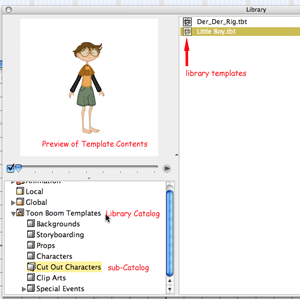
If for some reason you don't have a Toon Boom Templates catalog in your TBS library, you can get this catalog by just right clicking in the catalog listing pane to open the context menu and select the menu option to Reload Default Templates. That will restore the factory set default templates while not disturbing your other library catalogs or assets.
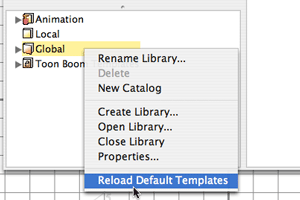
In order to use the Little boy character we need to click on his template in the library panel and drag it to our scene 1 time line. You want to drag the template label across to the time line track label pane and drop it at the top of the track label list. (You will see a "plus" icon (+) displayed when it is OK to drop the dragged template.) When we release the mouse button at the end of our drag we see the character's hierarchy of elements displayed in the time line track label list.
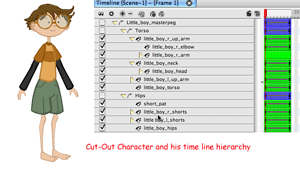
If you are not familiar with the time line and how it displays a hierarchy of elements, then this is a good time to spend a few minutes getting acquainted with it. Elements can be connected into hierarchical relationships where their behavior is controlled by their location in the hierarchy. Elements can be parents of other elements or children of other elements or they can be siblings (brothers or sisters) of other elements. A child element is influenced by its parent, a parent element is not influenced by its children. Siblings stay together based on the influence of their common parent. As we proceed, these relationships and their interactions will become obvious. The character hierarchy can be collapsed or expanded as needed and we will explore the advantages of doing both as we progress. For the moment we will fully expand the character's hierarchy to allow us to discuss some aspects of cut-out characters in general.
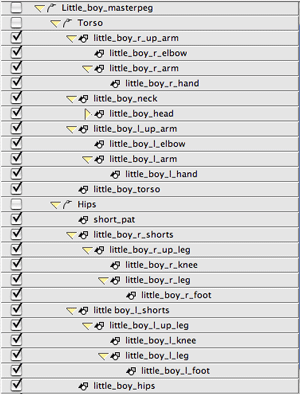
People and other animals are jointed. In fact the whole nature of articulated movement is based on joints, and even the fact that certain joints operate differently from other joints. Your shoulder joints, for example, have a different range of motion from your elbows, and your hip joints have a different range of motion from your knee joints etc. So, thinking about of how to construct a cartoon character to have articulated body parts and joints is to mirror nature.
If we go back and look at early cartoon character designs in the 1920’s and 1930’s they were actually very unnatural and based on “rubber” hose style limbs. That wasn’t an aesthetic choice as much as it was a practical design choice because those style limbs are much easier to animate than anatomically correct limbs. Disney artists in their efforts to create a more natural and realistic brand of cartoons quickly abandoned the “rubber” hoses in their characters. (Except in the case of Mickey Mouse, who was and to some extent still is drawn with "rubber" hose limbs.) Observations of natural organic movements quickly reveal that they are based on expansions and contractions of muscles under the character’s skin. Those observations made during the 1930s by Disney artists were the beginning of the application of squash and stretch in character animation. The character’s bones and joints provide the support structure as well as impose limitations on movement while muscular actions contort the shapes of body parts. “Full” animation captures these muscular expansions and contractions, while “limited” animation usually abbreviates them and often just ignores them for the most part for the sake of production efficiency.
Jointed characters have to be planned around their natural breaks. These natural breaks are how we subdivide the character into component parts and they usually fall on actual joints like shoulders, elbows, knees, ankles, hips, neck ect. Breaks are points of articulation but they shouldn’t be visually obvious. If you don't want your characters to look like hinged “cut-outs” then you need to plan and design with break camouflage in mind. (We will explore breaks and joint construction in future parts of this series)
The whole foundation of limited animation is based on holding the position of some body parts while changing the position of other body parts. This means we will want to separate our character into multiple parts and then each of those parts can then be held or changed as desired to produce the movement. So certainly the degree of granularity, that we decide to use to subdivide our character, is going to be a primary design decision. The more granular the subdivision, the more parts into which we will have to separate the character and potentially the more flexibility we will have in moving the character. But with greater flexibility comes greater complexity, more parts to account for in our animating, so we will have to weigh the cost of the flexibility we might gain against the extra work involved in managing a more complex character. Any body part that will need to be animated independently of all other body parts should be separated on to its own element layer. But we must evaluate which body parts truly need to be independent to satisfy our animating needs because that produces increased complexity. One part of that evaluation is the trade off between producing motion through articulation, the physical repositioning of body parts, and producing motion through drawing replacement. In many cases it isn’t always one way versus the other but actually a balanced combination of using both methods based on how we want to implement a movement. (We will get more into this discussion in future parts of this series.)
For now you should just look at the granular division of the Little Boy character and make note of how he has been constructed. Characteristic of cut-out characters he has a top parent peg element called the character's main peg or master peg. Then he has subdivisions of an upper and lower body, usually called torso and hips. Then these subdivisions are further divided into logical articulation chains. Notice the parents, their children and the various siblings in this character's hierarchy. (Again, there will be more discussion of this in future parts of this series)
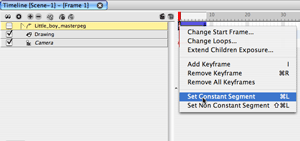
It's time to get started animating the Little Boy, so we need to make a few settings to assist us while we work. The template has some "tweening" included that we don't want at the moment. So we need to remove any non-constant segments. (If you are not up to speed on keyframed animation I highly suggest that you read Keyframed Animation Part 1 through Part 5 to insure you have a solid foundation before proceeding.) We want to select the scene operations transform tool and make it active and make sure your main view panel is set into camera view. Keyframing is always done exclusively in camera view and never uses drawing view. We start off by collapsing the character's master peg. Remember that when a parent peg is collapsed it not only hides its children's track labels, it also causes any actions that we apply to the parent also to be applied down to all its children. We select the collapsed master peg track and move the red frame location slider to frame 1 and we right click to open the context menu and select the menu option Set Constant Segment. The lines in the time line track that were connecting the first and last key frame in the keyframe pair are no longer showing which indicates that this is now a constant segment and if we expand the master peg, we will see this is now true for all its children tracks.
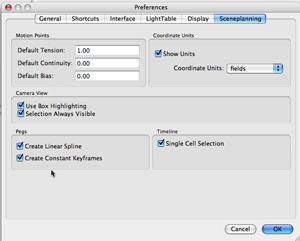
We also want to go to Preferences and make sure that we have checked the boxes shown in the above picture of the Scene Planning tab, particularly the Create Constant Keyframes setting. When working with animating a cut-out character it is best to not have TBS automatically create non-constant segments between keyframe pairs. We want to set all our segments individually as we animate them. So the default should be for no "tweening" which means constant segments.
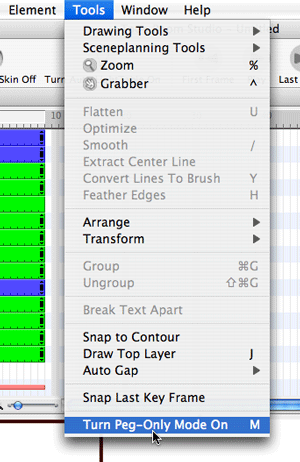
One more setting before we get going. We need to select the Turn Peg-Only Mode On (M) menu option under the Tools menu. This is a visual aid that helps us to not mistakenly select drawing objects when we are wanting to select pegs in camera view.
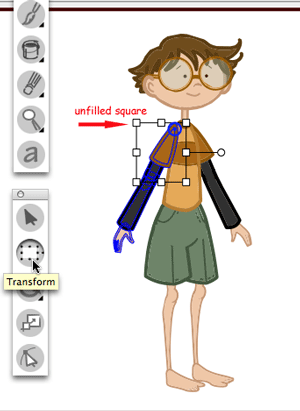
Cut-out character animating is done by posing the character in each frame using the scene operations tools, mostly the Transform tool (7). Notice that the Transform tool bounding box and the Select tool (6) bounding box look very similar in camera view. Visually the difference is that the grab handles are unfilled squares for the Transform tool and filled squares for the Select tool. Learn this distinction well as it will save you much grief in the future. These tools are very different in purpose and usage so don't be fooled by their similar displays. The Select tool is used to set "element" level parameters. The transform tool is used to set "frame" level parameters. As a general rule, you never want to change element level parameters once you start keyframe animating. Changes in element level parameters after you start keyframing can totally and unexpectedly alter all of your animation work and can be disastrous. Your only clue that you have the wrong tool selected is those filled grab handle squares. If your animating and see them, they are shouting to you "stop!! danger do not proceed!!".
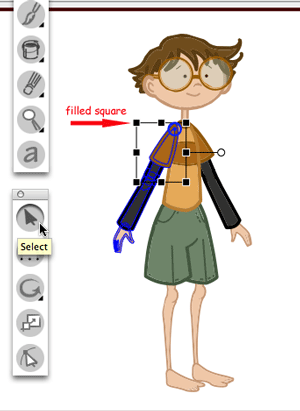
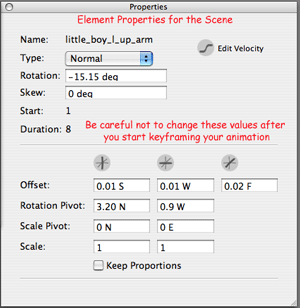
Before we start animating the Little Boy we might want to observe how his rotational pivot points have been preset. As part of the rigging of this character the designer used the Rotation tool (8) to position the "green" circle for each part and hierarchical grouping so that they would rotate around that point to insure more natural movement. Because this is an already rigged character, we will not need to worry about setting these pivot point locations. But it is important to note that rotational pivot point locations are "element" level settings and just like my previous warning about not changing "element" level settings after you start keyframe animating, don't change the location of rotational pivot points after you start keyframe animating, as the results can be unexpected and disastrous. If for any reason you need to use a different pivot point while keyframe animating, you can move the "blue" circle pivot point that is showing with the Transform tool bounding box. That pivot point is temporary and will only effect the transform setting as long as the current transform selection is active. Again this is a very important distinction that you should learn early or you will experience the consequences.
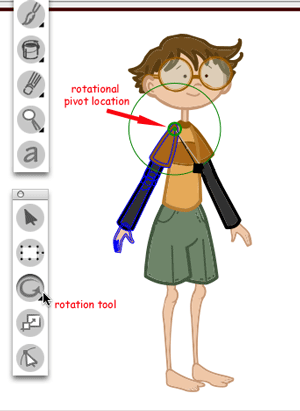
The template came set with eight frames so we want to extend the timeline out to twenty frames just to give ourselves some additional animating room. With the character's master peg collapsed and selected we move the red frame location slider to frame twenty and right click to show the context menu and select the menu option Extend Children Exposure... (this is a new command in version 4.)
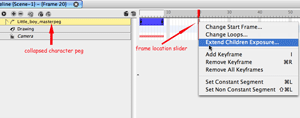
We also want to go back to frame 8 and select Remove Keyframe to get rid of that last keyframe that was also part of the template. Don't worry about making changes to a template once you drag it into your project time line. The original template in the library is not linked and therefore will not be changed in any way. (Warning: don't select Remove All Keyframes as that would be disasterous and totally destroy the character's rigging settings. Aren't you glad I'm pointing out the mines in this mine field before you get "blown" up.)
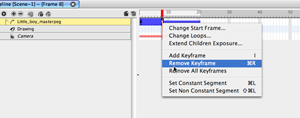
Finally we can start animating. So we will begin with a first pose for the Little Boy character. This is the natural pose of the template so we will just use it for our first pose in this example movement. We are going to animate the character's left arm. Our first pose is at frame 1 so there is nothing to change on frame one.
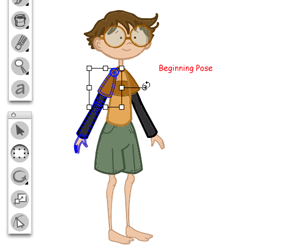
We will set our second pose for this example at frame 8. So move the red frame location slider to frame 8. Double check that you have the Transform tool selected as the active tool. Watch for those unfilled squares on the bounding box. Now you can visually try to select the character's left arm in camera view or you can select the track label in the time line track label list. I prefer the track label selection approach as it is easier most of the time. We want to select the track labeled "little_boy_l_up_arm".
You need to get use to being very focused and aware of your actions when animating a cut-out character. Before you move the character, always be sure you are working on the frame you want, always be sure the correct scene operations tool is selected and active, and always be sure you are setting keyframes on the element track that you want. This is a very important aspect of cut-out animation to understand, know where you are, what you are changing and how you are changing it before you change anything. And take your time, rushing causes mistakes and mistakes can multiply and get out of control quickly. ( I will try to show you how to undo most mistakes when you realize you have made them in a future part of this series, but fixing mistakes can waste a lot of time so it's better to move carefully and minimize the careless mistakes.)
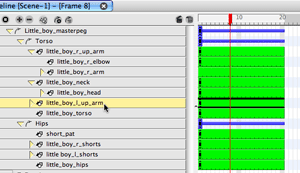
Notice that in camera view once we select the track label, the character's left arm is highlighted by the Transform tool's bounding box. We can rotate the arm by using the bounding box's rotate handle and dragging it counter clockwise to raise the shoulder. (note: that a change in version 4 now allows us to rotate the transformed object from any of its corners and not just using the rotation handle. In version 3.5 you still need to use the rotation handle.)
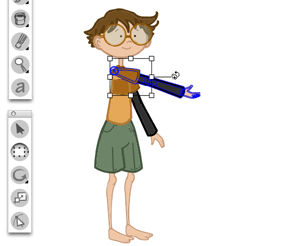
That repositioned the boys shoulder and upper arm, but we also want to move his lower arm position. Notice that because the lower arm and hand are children of the upper arm that they moved with the upper arm. But we have the ability to move them individually as well. There relationship to the upper arm is enforced as part of the relational hierarchy. So now we select the track labeled "little_boy_l_arm". This will let us just move the left lower arm and its child, the left hand.
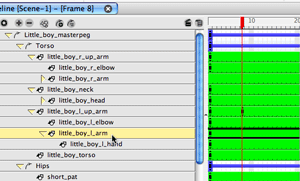
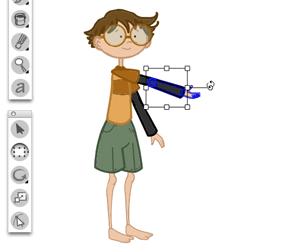
As you can see we can bend the arm naturally because of the way the character has been constructed and rigged. It is important that you begin to see that we are fundamentally posing a puppet. We can move the various body parts one at a time to get just the pose we want. Sometimes we will move a part like the upper arm, then we will move the lower arm and decide that the upper arm position needs to be re adjusted. This kind of iterative back and forth adjustment of parts is typical of posing a cut-out character.
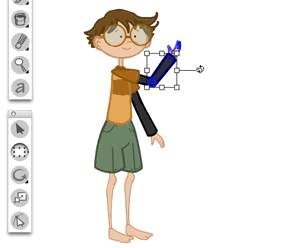
We can select and adjust the position of the left hand the same as we did the left upper arm and the left lower arm.
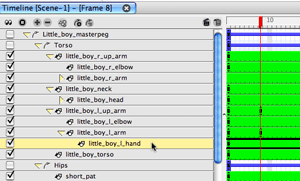
So now we have two poses for the Little Boy character. We are only focusing on his left arm to keep this example simple. His arm is positioned in pose one on frame 1 and is positioned in pose two on frame 8. If we looked at the animation at this point the arm would appear to "jump" between poses abruptly. So we want to smooth out the motion by adding incremental inbetween poses at frames 2,3,4,5,6,and 7. We could do these by hand just like pose one and pose two, but there is an easier way to proceed. We can use "tweening". We can select all the tracks for the Little Boy's left arm, move the red frame location slider to frame 1 and use the context menu option Set Non Constant Segment. This will generate the inbetween arm positions. The tracks show the line displayed between keyframes to indicate a non-constant segment.
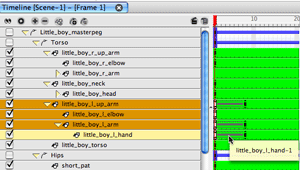
The picture below shows you the character poses. The two poses I set, and the six poses that TBS generated to inbetween my two poses. Now computer generated inbetween poses are a great time saver but they are usually just a starting point and most animators will fine tune and adjust those poses manually. ( In a future part of this series we will see how to fine tune and adjust the inbetweens generated by TBS.)
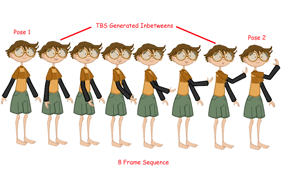
Click on the picture to see an enlarged version
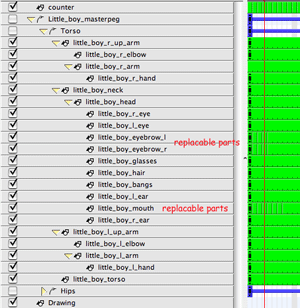
The last thing we want to look at in this first part of the Cut-Out series is the replacement parts included in this template. They are for the mouth and the eye brows. We aren't going to do any swapping of parts yet but I wanted to point them out for you to notice and study before we get to Part 2.
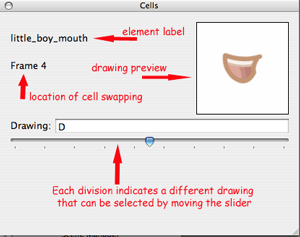
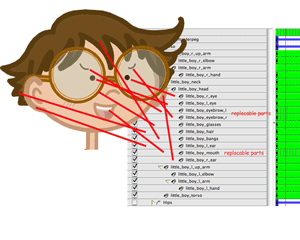
We have covered many fundamentals in Part 1 and we have learned basic rig manipulation to set a partial pose with the character. Next time we will learn to animate a full sequence of motions. Animating Cut-Out Characters - Part 2
This is the first in a series of tutorials about creating and animating “cut-out” characters. I’m going to try my best to be as in-depth as practical, so be patient, as my goal is to provide a definitive series on “cut-outs”. I plan to balance basic conceptual understanding of the subject with step by step “how to” guidance.
Initial Concepts
First, I want to clearly define what I mean by a “cut-out” character. A “cut-out” character is a character that has a multi-element hierarchy to create movable joints. Additionally a "cut-out" character will consist of replacement parts that can be swapped. Thus with the "cut-out" character we will combine articulation of jointed body parts with the replacement of body parts to create the illusion of movement.
In creating a hand drawn cartoon character we must consider how we will be animating that character. There are two fundamental approaches to producing hand drawn cartoon animation. There is the “full” animation approach and the “limited” animation approach. The “full” animation approach is to redraw the full character in its entirety for each frame that changes as we create the illusion of movement. The classical “limited” animation approach is to separate the character into layers and only redraw those layered parts that change in a frame while "holding" the unchanged layers. A common misconception is that the “limited” approach is a less skilled approach to animating then using the “full” approach. This actually is not the case. It requires every bit as much animating knowledge and skill to do classical “limited” animation, but it can reduce the amount of labor required to produce the final animation by reducing the amount of drawing needed. So the “limited” part has to do with drawing efficiency.
“Cut-out” animation in Toon Boom Studio is based on the “limited” animation approach and can be used to produce animation with even less drawing needed than classical “limited” animation. But again there is a common misconception that it requires less animating skills than fully drawn animation. It may not require as many drawing skills but it requires significant animating skills just the same. And even though it requires less drawing skills it requires even more skills in the areas of planning, construction and software usage. So don’t assume just because you are substituting a cut-out character for a fully drawn character that it is easier to implement. Successful cut-out animation is a highly skilled approach to animation production. Cut-out animating is not less skilled animation, it just uses different skills and places different emphasis on the animator’s skill sets.
For our purposes in this series we are primarily focused on “cut-out” characters to implement a form of “limited” animation. Where possible we will look at creating posable and animatible digital puppets, but at the same time we will also talk about replacement animation and the planning and reuse of drawing assets. Certainly there are styles of characters that lend themselves to more puppet-like construction and other styles of characters that really don't. Depending on the character style we may need to use a combination of both techniques. In fact, if you are familiar with stop motion animation techniques, you will realize that we are going to really end up designing our characters to be a jointed articulated puppet and we will also want to use replacement pieces for different character parts as well. Our goal is to produce the illusion of movement and we will do that sometimes using articulated joints to produce changes between images and other times we will change the drawing itself for certain body parts.
Getting Started
A sequential approach to working with cut-out characters might be:
1. Establishing a character concept.
2. Selecting design options based on the character's expected performance requirements. (performance is a theatrical term associated with acting)
3. Drawing a series of character poses and views.
4. Cutting the character up into parts.
5. Laying out the character parts in elements.
6. Rigging the character for animating.
7. Testing and Enhancing the character rig.
8. Animating the cut-out character.
But sometimes learning and mastering a complicated new technique isn't easiest when approached along the ultimate sequential work flow. A common mistake by new cartoon makers is to start trying to create and construct a cut-out character before they have a fundamental foundation in cut-out animating technique. We actually want to start at the end of the work flow, animating the cut-out character, and then we will work our way back to the creation of our own cut-out characters.
The Rigged Cut-Out Character
We will start by opening a new project in TBS and opening the library view panel. The library is divided into catalogs and those catalogs are divided into sub-catalogs. We want to go to the Toon Boom Templates catalog and find the sub-catalog named Cut-Out Characters. Inside that sub-catalog there are two character rigs. We will be using the character named Little Boy. (note: the Little Boy character is included in TBS version 4, if you don't have version 4 yet, then you can follow along using the Der Der character from version 3.5. The fundamentals are the same, and I will be careful to point out any variations in technique created by software usage changes.)

If for some reason you don't have a Toon Boom Templates catalog in your TBS library, you can get this catalog by just right clicking in the catalog listing pane to open the context menu and select the menu option to Reload Default Templates. That will restore the factory set default templates while not disturbing your other library catalogs or assets.

In order to use the Little boy character we need to click on his template in the library panel and drag it to our scene 1 time line. You want to drag the template label across to the time line track label pane and drop it at the top of the track label list. (You will see a "plus" icon (+) displayed when it is OK to drop the dragged template.) When we release the mouse button at the end of our drag we see the character's hierarchy of elements displayed in the time line track label list.

If you are not familiar with the time line and how it displays a hierarchy of elements, then this is a good time to spend a few minutes getting acquainted with it. Elements can be connected into hierarchical relationships where their behavior is controlled by their location in the hierarchy. Elements can be parents of other elements or children of other elements or they can be siblings (brothers or sisters) of other elements. A child element is influenced by its parent, a parent element is not influenced by its children. Siblings stay together based on the influence of their common parent. As we proceed, these relationships and their interactions will become obvious. The character hierarchy can be collapsed or expanded as needed and we will explore the advantages of doing both as we progress. For the moment we will fully expand the character's hierarchy to allow us to discuss some aspects of cut-out characters in general.

People and other animals are jointed. In fact the whole nature of articulated movement is based on joints, and even the fact that certain joints operate differently from other joints. Your shoulder joints, for example, have a different range of motion from your elbows, and your hip joints have a different range of motion from your knee joints etc. So, thinking about of how to construct a cartoon character to have articulated body parts and joints is to mirror nature.
If we go back and look at early cartoon character designs in the 1920’s and 1930’s they were actually very unnatural and based on “rubber” hose style limbs. That wasn’t an aesthetic choice as much as it was a practical design choice because those style limbs are much easier to animate than anatomically correct limbs. Disney artists in their efforts to create a more natural and realistic brand of cartoons quickly abandoned the “rubber” hoses in their characters. (Except in the case of Mickey Mouse, who was and to some extent still is drawn with "rubber" hose limbs.) Observations of natural organic movements quickly reveal that they are based on expansions and contractions of muscles under the character’s skin. Those observations made during the 1930s by Disney artists were the beginning of the application of squash and stretch in character animation. The character’s bones and joints provide the support structure as well as impose limitations on movement while muscular actions contort the shapes of body parts. “Full” animation captures these muscular expansions and contractions, while “limited” animation usually abbreviates them and often just ignores them for the most part for the sake of production efficiency.
Jointed characters have to be planned around their natural breaks. These natural breaks are how we subdivide the character into component parts and they usually fall on actual joints like shoulders, elbows, knees, ankles, hips, neck ect. Breaks are points of articulation but they shouldn’t be visually obvious. If you don't want your characters to look like hinged “cut-outs” then you need to plan and design with break camouflage in mind. (We will explore breaks and joint construction in future parts of this series)
The whole foundation of limited animation is based on holding the position of some body parts while changing the position of other body parts. This means we will want to separate our character into multiple parts and then each of those parts can then be held or changed as desired to produce the movement. So certainly the degree of granularity, that we decide to use to subdivide our character, is going to be a primary design decision. The more granular the subdivision, the more parts into which we will have to separate the character and potentially the more flexibility we will have in moving the character. But with greater flexibility comes greater complexity, more parts to account for in our animating, so we will have to weigh the cost of the flexibility we might gain against the extra work involved in managing a more complex character. Any body part that will need to be animated independently of all other body parts should be separated on to its own element layer. But we must evaluate which body parts truly need to be independent to satisfy our animating needs because that produces increased complexity. One part of that evaluation is the trade off between producing motion through articulation, the physical repositioning of body parts, and producing motion through drawing replacement. In many cases it isn’t always one way versus the other but actually a balanced combination of using both methods based on how we want to implement a movement. (We will get more into this discussion in future parts of this series.)
For now you should just look at the granular division of the Little Boy character and make note of how he has been constructed. Characteristic of cut-out characters he has a top parent peg element called the character's main peg or master peg. Then he has subdivisions of an upper and lower body, usually called torso and hips. Then these subdivisions are further divided into logical articulation chains. Notice the parents, their children and the various siblings in this character's hierarchy. (Again, there will be more discussion of this in future parts of this series)

It's time to get started animating the Little Boy, so we need to make a few settings to assist us while we work. The template has some "tweening" included that we don't want at the moment. So we need to remove any non-constant segments. (If you are not up to speed on keyframed animation I highly suggest that you read Keyframed Animation Part 1 through Part 5 to insure you have a solid foundation before proceeding.) We want to select the scene operations transform tool and make it active and make sure your main view panel is set into camera view. Keyframing is always done exclusively in camera view and never uses drawing view. We start off by collapsing the character's master peg. Remember that when a parent peg is collapsed it not only hides its children's track labels, it also causes any actions that we apply to the parent also to be applied down to all its children. We select the collapsed master peg track and move the red frame location slider to frame 1 and we right click to open the context menu and select the menu option Set Constant Segment. The lines in the time line track that were connecting the first and last key frame in the keyframe pair are no longer showing which indicates that this is now a constant segment and if we expand the master peg, we will see this is now true for all its children tracks.

We also want to go to Preferences and make sure that we have checked the boxes shown in the above picture of the Scene Planning tab, particularly the Create Constant Keyframes setting. When working with animating a cut-out character it is best to not have TBS automatically create non-constant segments between keyframe pairs. We want to set all our segments individually as we animate them. So the default should be for no "tweening" which means constant segments.

One more setting before we get going. We need to select the Turn Peg-Only Mode On (M) menu option under the Tools menu. This is a visual aid that helps us to not mistakenly select drawing objects when we are wanting to select pegs in camera view.

Cut-out character animating is done by posing the character in each frame using the scene operations tools, mostly the Transform tool (7). Notice that the Transform tool bounding box and the Select tool (6) bounding box look very similar in camera view. Visually the difference is that the grab handles are unfilled squares for the Transform tool and filled squares for the Select tool. Learn this distinction well as it will save you much grief in the future. These tools are very different in purpose and usage so don't be fooled by their similar displays. The Select tool is used to set "element" level parameters. The transform tool is used to set "frame" level parameters. As a general rule, you never want to change element level parameters once you start keyframe animating. Changes in element level parameters after you start keyframing can totally and unexpectedly alter all of your animation work and can be disastrous. Your only clue that you have the wrong tool selected is those filled grab handle squares. If your animating and see them, they are shouting to you "stop!! danger do not proceed!!".


Before we start animating the Little Boy we might want to observe how his rotational pivot points have been preset. As part of the rigging of this character the designer used the Rotation tool (8) to position the "green" circle for each part and hierarchical grouping so that they would rotate around that point to insure more natural movement. Because this is an already rigged character, we will not need to worry about setting these pivot point locations. But it is important to note that rotational pivot point locations are "element" level settings and just like my previous warning about not changing "element" level settings after you start keyframe animating, don't change the location of rotational pivot points after you start keyframe animating, as the results can be unexpected and disastrous. If for any reason you need to use a different pivot point while keyframe animating, you can move the "blue" circle pivot point that is showing with the Transform tool bounding box. That pivot point is temporary and will only effect the transform setting as long as the current transform selection is active. Again this is a very important distinction that you should learn early or you will experience the consequences.

The template came set with eight frames so we want to extend the timeline out to twenty frames just to give ourselves some additional animating room. With the character's master peg collapsed and selected we move the red frame location slider to frame twenty and right click to show the context menu and select the menu option Extend Children Exposure... (this is a new command in version 4.)

We also want to go back to frame 8 and select Remove Keyframe to get rid of that last keyframe that was also part of the template. Don't worry about making changes to a template once you drag it into your project time line. The original template in the library is not linked and therefore will not be changed in any way. (Warning: don't select Remove All Keyframes as that would be disasterous and totally destroy the character's rigging settings. Aren't you glad I'm pointing out the mines in this mine field before you get "blown" up.)

Finally we can start animating. So we will begin with a first pose for the Little Boy character. This is the natural pose of the template so we will just use it for our first pose in this example movement. We are going to animate the character's left arm. Our first pose is at frame 1 so there is nothing to change on frame one.

We will set our second pose for this example at frame 8. So move the red frame location slider to frame 8. Double check that you have the Transform tool selected as the active tool. Watch for those unfilled squares on the bounding box. Now you can visually try to select the character's left arm in camera view or you can select the track label in the time line track label list. I prefer the track label selection approach as it is easier most of the time. We want to select the track labeled "little_boy_l_up_arm".
You need to get use to being very focused and aware of your actions when animating a cut-out character. Before you move the character, always be sure you are working on the frame you want, always be sure the correct scene operations tool is selected and active, and always be sure you are setting keyframes on the element track that you want. This is a very important aspect of cut-out animation to understand, know where you are, what you are changing and how you are changing it before you change anything. And take your time, rushing causes mistakes and mistakes can multiply and get out of control quickly. ( I will try to show you how to undo most mistakes when you realize you have made them in a future part of this series, but fixing mistakes can waste a lot of time so it's better to move carefully and minimize the careless mistakes.)

Notice that in camera view once we select the track label, the character's left arm is highlighted by the Transform tool's bounding box. We can rotate the arm by using the bounding box's rotate handle and dragging it counter clockwise to raise the shoulder. (note: that a change in version 4 now allows us to rotate the transformed object from any of its corners and not just using the rotation handle. In version 3.5 you still need to use the rotation handle.)

That repositioned the boys shoulder and upper arm, but we also want to move his lower arm position. Notice that because the lower arm and hand are children of the upper arm that they moved with the upper arm. But we have the ability to move them individually as well. There relationship to the upper arm is enforced as part of the relational hierarchy. So now we select the track labeled "little_boy_l_arm". This will let us just move the left lower arm and its child, the left hand.


As you can see we can bend the arm naturally because of the way the character has been constructed and rigged. It is important that you begin to see that we are fundamentally posing a puppet. We can move the various body parts one at a time to get just the pose we want. Sometimes we will move a part like the upper arm, then we will move the lower arm and decide that the upper arm position needs to be re adjusted. This kind of iterative back and forth adjustment of parts is typical of posing a cut-out character.

We can select and adjust the position of the left hand the same as we did the left upper arm and the left lower arm.

So now we have two poses for the Little Boy character. We are only focusing on his left arm to keep this example simple. His arm is positioned in pose one on frame 1 and is positioned in pose two on frame 8. If we looked at the animation at this point the arm would appear to "jump" between poses abruptly. So we want to smooth out the motion by adding incremental inbetween poses at frames 2,3,4,5,6,and 7. We could do these by hand just like pose one and pose two, but there is an easier way to proceed. We can use "tweening". We can select all the tracks for the Little Boy's left arm, move the red frame location slider to frame 1 and use the context menu option Set Non Constant Segment. This will generate the inbetween arm positions. The tracks show the line displayed between keyframes to indicate a non-constant segment.

The picture below shows you the character poses. The two poses I set, and the six poses that TBS generated to inbetween my two poses. Now computer generated inbetween poses are a great time saver but they are usually just a starting point and most animators will fine tune and adjust those poses manually. ( In a future part of this series we will see how to fine tune and adjust the inbetweens generated by TBS.)

Click on the picture to see an enlarged version

The last thing we want to look at in this first part of the Cut-Out series is the replacement parts included in this template. They are for the mouth and the eye brows. We aren't going to do any swapping of parts yet but I wanted to point them out for you to notice and study before we get to Part 2.


We have covered many fundamentals in Part 1 and we have learned basic rig manipulation to set a partial pose with the character. Next time we will learn to animate a full sequence of motions. Animating Cut-Out Characters - Part 2
Labels: Cut-Out Animation, Key Framed Animation, Tutorial



5 Comments:
Incredibly detailed and very useful article, thank you JK. Cut-out character animation is a very refined skillset, and this is a great building block towards integrating that kind of animation with others.
Excellent tutorial. You explained a lot of things that I could not find the answers for.
Thanks
Brilliant tutorial. Keep up the good work. I learned more from this in 10 minutes than I did reading the official manual.
Cheers
If I have a "HAND_L" drawing nested into an "ARM_L" drawing, how can I stop the Hand_L displaying behind the arm sleeve? It has to be below the arm layer to move with the arm...
Usually you can right-click and go to Move To Front, but it seems missing on some drawings.
When the normal order of layering in a hierarchy list causes one element to be in front of or behind another element and that layering isn't what you need, then you want to move the object that needs to be in front in 3D or "Z" space which puts it on a different plane from the regular hierarchical layering list elements. I describe this in the Cartooning In ToonBoom WIKI on this page. It is under the heading of "The Z direction of 3D Space"(see the link below)
LAYERING ELEMENTS
Post a Comment
<< Home